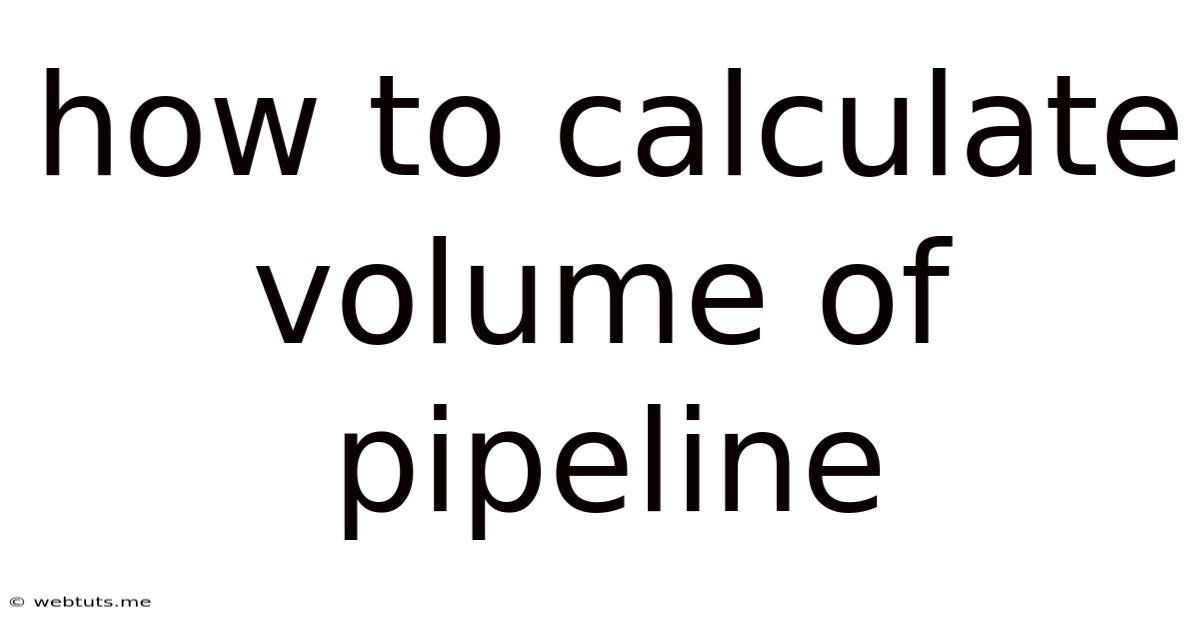How To Calculate Volume Of Pipeline
Webtuts
May 12, 2025 · 5 min read

Table of Contents
How to Calculate the Volume of a Pipeline: A Comprehensive Guide
Calculating the volume of a pipeline is crucial for various applications, from estimating the quantity of liquids or gases it can hold to determining the material needed for construction. This comprehensive guide will delve into different methods for calculating pipeline volume, catering to various pipeline shapes and scenarios. We'll cover everything from simple cylindrical pipelines to more complex configurations. Understanding these calculations is vital for engineers, contractors, and anyone involved in pipeline projects.
Understanding the Basics: Volume and its Units
Before diving into the calculations, let's establish a clear understanding of volume and its units of measurement. Volume refers to the amount of three-dimensional space occupied by an object or substance. Common units for volume include:
- Cubic meters (m³): The standard unit in the International System of Units (SI).
- Cubic feet (ft³): Commonly used in the United States and other countries.
- Cubic centimeters (cm³): Often used for smaller volumes.
- Liters (L) and gallons (gal): Liquid volume units, easily convertible to cubic units.
The choice of unit depends on the context and the scale of the pipeline project. Remember to maintain consistency in units throughout your calculations.
Calculating the Volume of a Cylindrical Pipeline: The Most Common Scenario
The vast majority of pipelines are cylindrical in shape. Calculating the volume of a cylindrical pipeline is straightforward, requiring only two measurements:
- Internal Radius (r): The radius of the pipeline's inside diameter. This is crucial for determining the usable volume.
- Length (l): The total length of the pipeline.
The formula for calculating the volume (V) of a cylinder is:
V = πr²l
Where:
- π (pi): Approximately 3.14159
- r²: The square of the internal radius
- l: The length of the pipeline
Example:
Let's say we have a pipeline with an internal radius of 0.5 meters and a length of 1000 meters. The calculation would be:
V = π * (0.5 m)² * 1000 m ≈ 785.4 m³
Therefore, the pipeline's internal volume is approximately 785.4 cubic meters.
Accounting for Pipeline Wall Thickness: Determining the External Volume
Often, you need to calculate the total volume, including the pipeline's wall. This requires knowing the external radius (R) or the wall thickness (t). The relationship between these is:
R = r + t
Once you have the external radius, you can calculate the external volume (V<sub>ext</sub>) using the same cylindrical volume formula:
V<sub>ext</sub> = πR²l
The volume of the pipeline wall itself (V<sub>wall</sub>) can then be calculated by subtracting the internal volume from the external volume:
V<sub>wall</sub> = V<sub>ext</sub> - V
Dealing with Non-Cylindrical Pipelines: More Complex Scenarios
While most pipelines are cylindrical, some may have variations in shape. Let's examine how to handle these more complex scenarios:
1. Tapered Pipelines: Varying Radius
For pipelines with a gradually changing radius (tapered pipelines), a simple cylindrical volume calculation won't suffice. In such cases, you might need to use calculus (integration) to find the precise volume. However, a reasonable approximation can be obtained by dividing the pipeline into several shorter cylindrical sections, calculating the volume of each section, and then summing the results. The accuracy of this approximation increases with the number of sections used.
2. Pipelines with Bends and Curves: Approximation Techniques
Significant bends and curves complicate the volume calculation. Again, precise calculation often requires advanced mathematical techniques. A practical approach involves approximating the curved sections as a series of short cylindrical segments, similar to the method for tapered pipelines. The more segments you use, the more accurate your approximation will be. Specialized software might be necessary for highly complex geometries.
3. Pipelines with Irregular Cross-Sections: Advanced Methods
Pipelines with irregular cross-sections necessitate more advanced methods. Numerical techniques, such as finite element analysis (FEA), can provide accurate volume estimations. These methods usually require specialized software and expertise.
Practical Considerations and Error Minimization
Several practical considerations can significantly impact the accuracy of your volume calculations:
- Measurement Accuracy: Precise measurements of the internal radius and length are paramount. Using appropriate measuring tools and techniques is vital to minimize errors.
- Pipeline Material Properties: Temperature changes can affect the dimensions of the pipeline, potentially affecting volume calculations. Consider thermal expansion coefficients when working with high-temperature applications.
- Pipeline Condition: Corrosion, dents, or other damage can alter the pipeline's internal dimensions, leading to inaccuracies. Regular pipeline inspections are essential for reliable volume estimations.
- Fluid Properties: When dealing with liquids or gases, the compressibility of the fluid can influence the effective volume. This is particularly relevant for gases under high pressure.
Utilizing Software and Tools for Volume Calculation
Numerous software packages are designed to simplify pipeline volume calculations, especially for complex geometries. These tools often incorporate advanced numerical techniques and can handle various pipeline shapes and configurations. Some examples include CAD software, specialized pipeline engineering software, and even spreadsheets with built-in mathematical functions.
Conclusion: Accuracy and Precision in Pipeline Volume Calculation
Accurately calculating the volume of a pipeline is crucial for various engineering and logistical purposes. While the basic cylindrical volume calculation provides a foundation, understanding and addressing the complexities associated with non-cylindrical shapes, material properties, and environmental factors is vital for achieving precise results. Remember to always prioritize accurate measurements and choose the appropriate calculation method based on the pipeline's geometry and the level of precision required. By combining theoretical understanding with the use of appropriate tools and techniques, you can ensure reliable and accurate volume calculations for your pipeline projects.
Latest Posts
Related Post
Thank you for visiting our website which covers about How To Calculate Volume Of Pipeline . We hope the information provided has been useful to you. Feel free to contact us if you have any questions or need further assistance. See you next time and don't miss to bookmark.